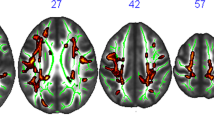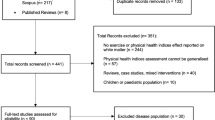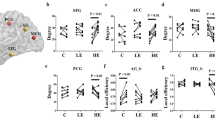Abstract
Although endurance running (ER) seems to be a simple repetitive exercise, good ER performance also requires and relies on multiple cognitive and motor control processes. Most of previous neuroimaging studies on ER were conducted using a single MRI modality, yet no multimodal study to our knowledge has been performed in this regard. In this study, we used multimodal MRI data to investigate the brain structural and functional differences between endurance runners (n = 22; age = 26.27 ± 6.07 years; endurance training = 6.23 ± 2.41 years) and healthy controls (HCs; n = 20; age = 24.60 ± 4.14 years). Compared with the HCs, the endurance runners showed greater gray matter volume (GMV) and cortical surface area in the left precentral gyrus, which at the same time had higher functional connectivity (FC) with the right postcentral and precentral gyrus. Subcortically, the endurance runners showed greater GMV in the left hippocampus and regional inflation in the right hippocampus. Using the bilateral hippocampi as seeds, further seed-based FC analyses showed higher hippocampal FC with the supplementary motor area, middle cingulate cortex, and left posterior lobe of the cerebellum. Moreover, compared with the HCs, the endurance runners also showed higher fractional anisotropy in several white matter regions, involving the corpus callosum, left internal capsule, left corona radiata, left external capsule, left posterior lobe of cerebellum and bilateral precuneus. Taken together, our findings provide several lines of evidence for the brain structural and functional differences between endurance runners and HCs. The current data suggest that these brain characteristics may have arisen as a result of regular ER training; however, whether they represent the neural correlates underlying the good ER performances of the endurance runners requires further investigations.





Similar content being viewed by others
References
Broadbent NJ, Squire LR, Clark RE (2004) Spatial memory, recognition memory, and the hippocampus. Proc Natl Acad Sci USA 101(40):14515–14520. https://doi.org/10.1073/pnas.0406344101
Chaddock L, Erickson KI, Prakash RS, Kim JS, Voss MW, VanPatter M, Pontifex MB, Raine LB, Konkel A, Hillman CH, Cohen NJ, Kramer AF (2010) A neuroimaging investigation of the association between aerobic fitness, hippocampal volume, and memory performance in preadolescent children. Brain Res 1358:172–183. https://doi.org/10.1016/j.brainres.2010.08.049
Chang YK, Tsai JH, Wang CC, Chang EC (2015) Structural differences in basal ganglia of elite running versus martial arts athletes: a diffusion tensor imaging study. Exp Brain Res 233(7):2239–2248. https://doi.org/10.1007/s00221-015-4293-x
Cona G, Cavazzana A, Paoli A, Marcolin G, Grainer A, Bisiacchi PS (2015) It’s a matter of mind! cognitive functioning predicts the athletic performance in ultra-marathon runners. PLoS ONE 10(7):e0132943. https://doi.org/10.1371/journal.pone.0132943
Den Ouden L, Kandola A, Suo C, Hendrikse J, Costa RJS, Watt MJ, Lorenzetti V, Chye Y, Parkes L, Sabaroedin K, Yucel M (2018) The influence of aerobic exercise on hippocampal integrity and function: preliminary findings of a multi-modal imaging analysis. Brain Plast 4(2):211–216. https://doi.org/10.3233/BPL-170053
Domin M, Lotze M (2019) Parcellation of motor cortex-associated regions in the human corpus callosum on the basis of Human Connectome Project data. Brain Struct Funct 224(4):1447–1455. https://doi.org/10.1007/s00429-019-01849-1
Ekstrom AD, Kahana MJ, Caplan JB, Fields TA, Isham EA, Newman EL, Fried I (2003) Cellular networks underlying human spatial navigation. Nature 425(6954):184–188. https://doi.org/10.1038/nature01964
Erickson KI, Voss MW, Prakash RS, Basak C, Szabo A, Chaddock L, Kim JS, Heo S, Alves H, White SM, Wojcicki TR, Mailey E, Vieira VJ, Martin SA, Pence BD, Woods JA, McAuley E, Kramer AF (2011) Exercise training increases size of hippocampus and improves memory. Proc Natl Acad Sci USA 108(7):3017–3022. https://doi.org/10.1073/pnas.1015950108
Friedrich J, Muckschel M, Beste C (2018) Specific properties of the SI and SII somatosensory areas and their effects on motor control: a system neurophysiological study. Brain Struct Funct 223(2):687–699. https://doi.org/10.1007/s00429-017-1515-y
Frodl T, Strehl K, Carballedo A, Tozzi L, Doyle M, Amico F, Gormley J, Lavelle G, O’Keane V (2019) Aerobic exercise increases hippocampal subfield volumes in younger adults and prevents volume decline in the elderly. Brain Imaging Behav. https://doi.org/10.1007/s11682-019-00088-6
Fuhrmann F, Justus D, Sosulina L, Kaneko H, Beutel T, Friedrichs D, Schoch S, Schwarz MK, Fuhrmann M, Remy S (2015) Locomotion, theta oscillations, and the speed-correlated firing of hippocampal neurons are controlled by a medial septal glutamatergic circuit. Neuron 86(5):1253–1264. https://doi.org/10.1016/j.neuron.2015.05.001
Hulteen RM, Smith JJ, Morgan PJ, Barnett LM, Hallal PC, Colyvas K, Lubans DR (2017) Global participation in sport and leisure-time physical activities: a systematic review and meta-analysis. Prev Med 95:14–25. https://doi.org/10.1016/j.ypmed.2016.11.027
Igloi K, Doeller CF, Paradis AL, Benchenane K, Berthoz A, Burgess N, Rondi-Reig L (2015) Interaction between hippocampus and cerebellum crus i in sequence-based but not place-based navigation. Cereb Cortex 25(11):4146–4154. https://doi.org/10.1093/cercor/bhu132
Jenkinson M, Bannister P, Brady M, Smith S (2002) Improved optimization for the robust and accurate linear registration and motion correction of brain images. Neuroimage 17(2):825–841. https://doi.org/10.1006/nimg.2002.1132
Jenkinson M, Beckmann CF, Behrens TE, Woolrich MW, Smith SM (2012) Fsl. Neuroimage 62(2):782–790. https://doi.org/10.1016/j.neuroimage.2011.09.015
Kawai R, Markman T, Poddar R, Ko R, Fantana AL, Dhawale AK, Kampff AR, Olveczky BP (2015) Motor cortex is required for learning but not for executing a motor skill. Neuron 86(3):800–812. https://doi.org/10.1016/j.neuron.2015.03.024
Lara B, Salinero JJ, Del Coso J (2014) The relationship between age and running time in elite marathoners is U-shaped. Age 36(2):1003–1008. https://doi.org/10.1007/s11357-013-9614-z
Lee KM, Chang KH, Roh JK (1999) Subregions within the supplementary motor area activated at different stages of movement preparation and execution. Neuroimage 9(1):117–123. https://doi.org/10.1006/nimg.1998.0393
Lillicrap TP, Scott SH (2013) Preference distributions of primary motor cortex neurons reflect control solutions optimized for limb biomechanics. Neuron 77(1):168–179. https://doi.org/10.1016/j.neuron.2012.10.041
Liu XY, Yang X, Hou ZH, Ma M, Jiang WH, Wang CY, Zhang YQ, Yuan YG (2019) Increased interhemispheric synchrony underlying the improved athletic performance of rowing athletes by transcranial direct current stimulation. Brain Imaging Behav 13(5):1324–1332. https://doi.org/10.1007/s11682-018-9948-3
Lopez Ruiz JR, Osuna Carrasco LP, Lopez Valenzuela CL, Franco Rodriguez NE, de la Torre VB, Jimenez Estrada I, Duenas Jimenez JM, Duenas Jimenez SH (2015) The hippocampus participates in the control of locomotion speed. Neuroscience 311:207–215. https://doi.org/10.1016/j.neuroscience.2015.10.034
Lucia A, Olivan J, Bravo J, Gonzalez-Freire M, Foster C (2008) The key to top-level endurance running performance: a unique example. Brit J Sport Med 42(3):172–174. https://doi.org/10.1136/bjsm.2007.040725
Miller J, Watrous AJ, Tsitsiklis M, Lee SA, Sheth SA, Schevon CA, Smith EH, Sperling MR, Sharan A, Asadi-Pooya AA, Worrell GA, Meisenhelter S, Inman CS, Davis KA, Lega B, Wanda PA, Das SR, Stein JM, Gorniak R, Jacobs J (2018) Lateralized hippocampal oscillations underlie distinct aspects of human spatial memory and navigation. Nat Commun 9(1):2423. https://doi.org/10.1038/s41467-018-04847-9
Miller KJ, Schalk G, Fetz EE, den Nijs M, Ojemann JG, Rao RP (2010) Cortical activity during motor execution, motor imagery, and imagery-based online feedback. Proc Natl Acad Sci USA 107(9):4430–4435. https://doi.org/10.1073/pnas.0913697107
Morecraft RJ, Herrick JL, Stilwell-Morecraft KS, Louie JL, Schroeder CM, Ottenbacher JG, Schoolfield MW (2002) Localization of arm representation in the corona radiata and internal capsule in the non-human primate. Brain 125(Pt 1):176–198. https://doi.org/10.1093/brain/awf011
Morton SM, Bastian AJ (2004) Cerebellar control of balance and locomotion. Neuroscientist 10(3):247–259. https://doi.org/10.1177/1073858404263517
Nikolaidis PT, Alvero-Cruz JR, Villiger E, Rosemann T, Knechtle B (2019) the age-related performance decline in marathon running: the paradigm of the Berlin marathon. Int J Environ Res Public Health. https://doi.org/10.3390/ijerph16112022
Opel N, Martin S, Meinert S, Redlich R, Enneking V, Richter M, Goltermann J, Johnen A, Dannlowski U, Repple J (2019) White matter microstructure mediates the association between physical fitness and cognition in healthy, young adults. Sci Rep 9(1):12885. https://doi.org/10.1038/s41598-019-49301-y
Patenaude B, Smith SM, Kennedy DN, Jenkinson M (2011) A Bayesian model of shape and appearance for subcortical brain segmentation. Neuroimage 56(3):907–922. https://doi.org/10.1016/j.neuroimage.2011.02.046
Raichlen DA, Bharadwaj PK, Fitzhugh MC, Haws KA, Torre GA, Trouard TP, Alexander GE (2016) Differences in resting state functional connectivity between young adult endurance athletes and healthy controls. Front Hum Neurosci 10:610. https://doi.org/10.3389/fnhum.2016.00610
Reaburn P, Dascombe B (2008) Endurance performance in masters athletes. Eur Rev Aging Phys A 5(1):31–42. https://doi.org/10.1007/s11556-008-0029-2
Sanes JN, Donoghue JP, Thangaraj V, Edelman RR, Warach S (1995) Shared neural substrates controlling hand movements in human motor cortex. Science 268(5218):1775–1777. https://doi.org/10.1126/science.7792606
Schlaffke L, Lissek S, Lenz M, Brune M, Juckel G, Hinrichs T, Platen P, Tegenthoff M, Schmidt-Wilcke T (2014) Sports and brain morphology—a voxel-based morphometry study with endurance athletes and martial artists. Neuroscience 259:35–42. https://doi.org/10.1016/j.neuroscience.2013.11.046
Smith SM (2002) Fast robust automated brain extraction. Hum Brain Mapp 17(3):143–155. https://doi.org/10.1002/hbm.10062
Squire LR (1992) Memory and the hippocampus: a synthesis from findings with rats, monkeys, and humans. Psychol Rev 99(2):195–231. https://doi.org/10.1037/0033-295x.99.2.195
Tanaka H, Seals DR (2008) Endurance exercise performance in Masters athletes: age-associated changes and underlying physiological mechanisms. J Physiol 586(1):55–63. https://doi.org/10.1113/jphysiol.2007.141879
Tanji J, Shima K (1994) Role for supplementary motor area cells in planning several movements ahead. Nature 371(6496):413–416. https://doi.org/10.1038/371413a0
Thach WT, Goodkin HP, Keating JG (1992) The cerebellum and the adaptive coordination of movement. Annu Rev Neurosci 15:403–442. https://doi.org/10.1146/annurev.ne.15.030192.002155
Thomas AG, Dennis A, Rawlings NB, Stagg CJ, Matthews L, Morris M, Kolind SH, Foxley S, Jenkinson M, Nichols TE, Dawes H, Bandettini PA, Johansen-Berg H (2016) Multi-modal characterization of rapid anterior hippocampal volume increase associated with aerobic exercise. Neuroimage 131:162–170. https://doi.org/10.1016/j.neuroimage.2015.10.090
Tseng BY, Gundapuneedi T, Khan MA, Diaz-Arrastia R, Levine BD, Lu H, Huang H, Zhang R (2013) White matter integrity in physically fit older adults. Neuroimage 82:510–516. https://doi.org/10.1016/j.neuroimage.2013.06.011
Tseng BY, Uh J, Rossetti HC, Cullum CM, Diaz-Arrastia RF, Levine BD, Lu HZ, Zhang R (2013) Masters athletes exhibit larger regional brain volume and better cognitive performance than sedentary older adults. J Magn Reson Imaging 38(5):1169–1176. https://doi.org/10.1002/jmri.24085
Tzourio-Mazoyer N, Landeau B, Papathanassiou D, Crivello F, Etard O, Delcroix N, Mazoyer B, Joliot M (2002) Automated anatomical labeling of activations in SPM using a macroscopic anatomical parcellation of the MNI MRI single-subject brain. Neuroimage 15(1):273–289. https://doi.org/10.1006/nimg.2001.0978
Vogt BA (2016) Midcingulate cortex: Structure, connections, homologies, functions and diseases. J Chem Neuroanat 74:28–46. https://doi.org/10.1016/j.jchemneu.2016.01.010
Wang X, Casadio M, Weber KA, Mussa-Ivaldi FA, Parrish TB (2014) White matter microstructure changes induced by motor skill learning utilizing a body machine interface. Neuroimage 88:32–40. https://doi.org/10.1016/j.neuroimage.2013.10.066
Wang Y, Zhang Y, Zhang J, Wang J, Xu J, Li J, Cui G, Zhang J (2018) Structural and functional abnormalities of the insular cortex in trigeminal neuralgia: a multimodal magnetic resonance imaging analysis. Pain 159(3):507–514. https://doi.org/10.1097/j.pain.0000000000001120
Wittfeld K, Jochem C, Dorr M, Schminke U, Glaser S, Bahls M, Markus MRP, Felix SB, Leitzmann MF, Ewert R, Bulow R, Volzke H, Janowitz D, Baumeister SE, Grabe HJ (2020) Cardiorespiratory fitness and gray matter volume in the temporal, frontal, and cerebellar regions in the general population. Mayo Clin Proc 95(1):44–56. https://doi.org/10.1016/j.mayocp.2019.05.030
Wood KN, Nikolov R, Shoemaker JK (2016) Impact of long-term endurance training vs. guideline-based physical activity on brain structure in healthy aging. Front Aging Neurosci 8:155. https://doi.org/10.3389/fnagi.2016.00155
Woolrich MW, Jbabdi S, Patenaude B, Chappell M, Makni S, Behrens T, Beckmann C, Jenkinson M, Smith SM (2009) Bayesian analysis of neuroimaging data in FSL. Neuroimage 45(1 Suppl):S173-186. https://doi.org/10.1016/j.neuroimage.2008.10.055
Yogev-Seligmann G, Hausdorff JM, Giladi N (2008) The role of executive function and attention in gait. Move Disord 23(3):329–342. https://doi.org/10.1002/mds.21720
Zhang Y, Qiu T, Yuan X, Zhang J, Wang Y, Zhang N, Zhou C, Luo C, Zhang J (2019) Abnormal topological organization of structural covariance networks in amyotrophic lateral sclerosis. Neuroimage Clin 21:101619. https://doi.org/10.1016/j.nicl.2018.101619
Zhang Y, Qu M, Yi X, Zhuo P, Tang J, Chen X, Zhou G, Hu P, Qiu T, Xing W, Mao Y, Chen BT, Wu J, Zhang Y, Liao W (2020) Sensorimotor and pain-related alterations of the gray matter and white matter in Type 2 diabetic patients with peripheral neuropathy. Hum Brain Mapp 41(3):710–725. https://doi.org/10.1002/hbm.24834
Acknowledgements
This study was funded by the National Natural Science Foundation of China [Grant Number 11002036]; the Fundamental Research Funds for the Central Universities [Grant Number 2672018ZYGX2018J075]; the Humanities and Social Science of Shenzhen University [Grant Number 17QNFC59]; and the Youth cultivation program of Xi'an Health Commission [Grant Number 2020QN03].
Funding
This study was funded by the National Natural Science Foundation of China [Grant Number 11002036]; the Fundamental Research Funds for the Central Universities [Grant Number 2672018ZYGX2018J075]; the Humanities and Social Science of Shenzhen University [Grant Number 17QNFC59]; and the Youth cultivation program of Xi'an Health Commission [Grant Number 2020QN03].
Author information
Authors and Affiliations
Contributions
LC was responsible for the methodology development, formal analysis, manuscript writing (preparation and editing), and data visualization; YCZ was responsible for the study conceptualization, methodology development and validation, formal analysis, manuscript writing (preparation and editing), data visualization, and funding acquisition; RWH, LXL, FGX, LYZ, QY and JYL were responsible for the study investigation; FH, SP, PM, MD and PL were responsible for the writing (editing); YW was responsible for the methodology development and writing (preparation); YDM was responsible for the study investigation; HFZ, SCQ and JLW were responsible for the study investigation and project administration; ZBR was responsible for the study conceptualization, investigation and supervision, project administration, writing (editing), and funding acquisition. All authors have read and approved the final version of the manuscript, and agree with the order of presentation of the authors.
Corresponding authors
Ethics declarations
Conflict of interest
The authors declare that they have no conflict of interest.
Ethical approval
All procedures performed in studies involving human participants were in accordance with the ethical standards of the institutional and/or national research committee and with the 1964 Helsinki Declaration and its later amendments or comparable ethical standards.
Informed consent
Informed consent was obtained from all individual participants included in the study.
Data and code availability
The data and codes that support the findings of this study are available from the corresponding author upon reasonable request.
Additional information
Publisher's Note
Springer Nature remains neutral with regard to jurisdictional claims in published maps and institutional affiliations.
Electronic supplementary material
Below is the link to the electronic supplementary material.
Rights and permissions
About this article
Cite this article
Cao, L., Zhang, Y., Huang, R. et al. Structural and functional brain signatures of endurance runners. Brain Struct Funct 226, 93–103 (2021). https://doi.org/10.1007/s00429-020-02170-y
Received:
Accepted:
Published:
Issue Date:
DOI: https://doi.org/10.1007/s00429-020-02170-y




